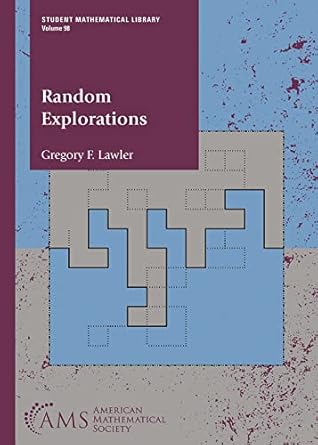
- Author: Gregory F. Lawler
- Series: Student Mathematical Library
- Publisher: American Mathematical Society
- Publication Date: 12/06/2022
- Number of Pages: 199
- Format: Paperback
- Price: $59
- ISBN: 978-1-4704-6766-1
- Category: textbook
[Reviewed by Bill Satzer , on 04/08/2025]
This book is part of the AMS Student Mathematical Library series and was developed following
a course the author offered in a 2020 Research Experiences for Undergraduates (REU) setting.
The author explains that the title can be interpreted as both a random sampling of some objects
that arise in probability and statistical mechanics, and as a prevailing theme of many of those
models in which random fields appear.
The topics wouldn’t necessarily fit in a standard course, but it does follow the pattern of other
REU programs that offer samples of graduate and research level mathematics. Students would
probably find this book a good deal more challenging than others in this series.
The author mostly concentrates on discrete models where experience with measure theory is not
required. The background expected includes advanced calculus, linear algebra, and a probability
course based on calculus. The treatment tends to be very theoretical, and readers should expect to
see a lot of rigorous arguments. There are few examples and very little is offered in the way of
motivation.
The author begins by introducing Markov chains. His focus is on transient chains or recurrent
chains with “killing”. Here he presents a finite Green’s function that represents the expected
number of visits to sites. He explains that the Green’s function can be interpreted as the inverse
of a Laplacian operator.
This is followed by introduction of loop-erased random walk, which has been a regular part of
the author’s research, and one aimed at addressing challenging problem of the self-avoiding
random walk. From this the author moves on to loop soups and the measures that measures that
are associated with them. The treatment comes back to simple random walks on a lattice before
considering infinite spanning trees on an integer lattice. The final two sections take up Gaussian
free fields, especially those arising from Markov chains, and then continuous models that arise as
scaling limits.
This is a text that would challenge even the best advanced students. Readers who would
approach this would benefit from some prior background on Markov chains and random walks
from a source such as they might find in Understanding Markov Chains by Nicolas Privault.
A bibliography and a few exercises are provided.
Bill Satzer (bsatzer@gmail.com), now retired from 3M Company, spent most of his career as a mathematician working in industry on a variety of applications. He did his PhD work in dynamical systems and celestial mechanics.